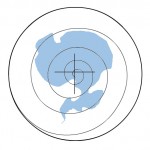
Knowledge of ice came from people at sea before satellite imagery.
According to this article from the Sydney Morning Herald, large icebergs drifting north ‘could become more frequent if sea temperatures rise through global warming’.
Giant iceberg spotted south of Australia
December 9, 2009 – 7:34PM
A monster iceberg has been spotted drifting towards Australia in what scientists Wednesday called a once-in-a-century event.
Australian glaciologist Neal Young pinpointed the slab, which is some 19 kilometres (12 miles) long, about 1,700 kilometres south of the country, using satellite imagery.
He said he was not aware of such a large iceberg being found in the area since the days when 19th century clipper ships plied the trade route between Britain and Australia.
“I don’t recall any mention of one for a long, long time,” Young, of the Australian Antarctic Division and Antarctic Climate and Ecosystems Cooperative Research Centre, told AFP.
“I’m guessing you would probably have to go back to the times of the clipper ships.”
Young said the iceberg measured about 140 square kilometres (54 square miles).
The glaciologist saidd the iceberg carved off the Antarctic about 10 years ago and had been slowly floating round the icy continent before taking the unusual route north.
He said the “very, very big” iceberg was originally about 400 square kilometres but then split into two smaller pieces.
“This one has survived in the open ocean for about a year,” he said. “In that time it’s slowly been coming up to the north and north east in the general direction of Western Australia.”
The finding comes after two large icebergs were spotted further east, off Australia’s Macquarie Island, followed by more than 100 smaller ice chunks heading towards New Zealand.
Young described the icebergs as uncommon, but said they could become more frequent if sea temperatures rise through global warming.
© 2009 AFP
This story is sourced direct from an overseas news agency as an additional service to readers. Spelling follows North American usage, along with foreign currency and measurement units.
